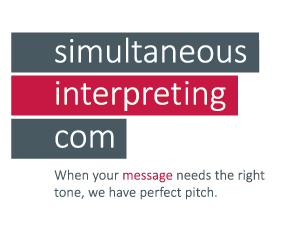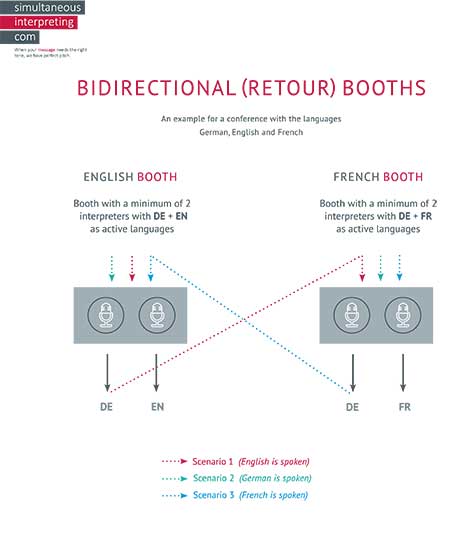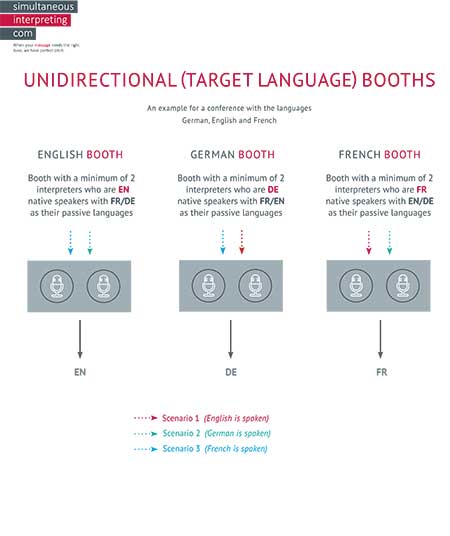Conference Interpreting
As an expert conference interpreter, Andrea Wilming draws on her extensive 7-year interpreter studies culminating in a degree at the University of Heidelberg as well as her experience acquired through interpreting over several hundred conference days. As a senior member of the German Association of Conference Interpreters (VKD), she stands for professionalism and adherence to ethical standards.
simultaneous
In simultaneous interpreting, the transfer into the foreign language (s) takes place with only a few seconds time delay from the original. This quasi-simultaneous interpretation is an elegant solution for professional congresses or high-level meetings, to name just a few circumstances where it would be suitable. The interpreters are required to exert the highest level of concentration and so consequently alternate every 20 to 30 minutes.
consecutive
Consecutive interpreting takes place on a time-delayed basis. The interpreters transfer the words into the target language in sections and sit or stand directly next to the speaker. The complex memory performance required for this is supported by a specially developed note-taking technique.
WHISPERED INTERPRETING
This is a form of simultaneous interpreting, without the use of a sound-proof interpreting booth. For very short events, this is often the interpreting mode of choice, with a surcharge added to the normal fee as this setting is both extremely demanding for the interpreters and—due to the noise—not always relaxed for the listeners.
LIAISON INTERPRETING
In this subtype of consecutive interpreting, the interpreters sit at the negotiating table and interpret bilaterally in shorter sections, always striving to avoid disrupting the natural flow of communication as much as possible.
Escort interpreting
Escort interpreting is suitable for tours with changes of location or for the linguistic support of a delegation. In this scenario, theoretically all interpreting forms can be varied in order to take account of the respective situation.
CONFERENCE INTERPRETING SERVICE PROVIDER
Your project manager is trained as a conference interpreter, has extensive experience both as an interpreter in the booth and a consultant interpreter, is exceptionally well connected through professional associations and other platforms and will be happy to advise you on the best language solution for your conference or meeting.
REFERENCE PROJECT 1
Single source solutions: 16 interpreters for five languages in four parallel sessions plus interpreting equipment for a five-day international youth event with lectures and workshops. A tremendous success with a bi-directional booth solution (verlinken mit der entsprechenden Grafik, entweder nur das Wort „bi-directional“ oder alle drei Wörter) – June 2013
REFERENCE PROJECT 2
Never change a winning team: 10 interpreters for five languages for a two-day committee meeting in Brussels, Belgium. At the request of the client, we hired a team for mono-directional booths (verlinken mit der entsprechenden Grafik, entweder nur das Wort „mono-directional“ oder alle drei Wörter), as is customary in the EU institutions – October 2015.
REFERENCE PROJECT 3
Legal meets IT: A team of interpreters covering the languages DE, EN, NL, CZ, FR and PL for an international expert conference in Germany. Excellent cooperation with the event agency from Cologne – April 2014.
REFERENCE PROJECT 4
I’d like the same team as last time: No problem, these 10 interpreters for six languages worked at both meetings, in Dublin (Ireland) and Stockholm (Sweden). Seamless project management for this trade union federation – October 2014 and May 2015.
FAQ
Yes, but also consecutive and all subtypes of these two types of interpreting, such as whispered interpreting, liaison interpreting for meetings or negotiations, escort interpreting for delegations, etc. However, simultaneous interpreting has the highest adrenalin factor for me.
The level of concentration and the cognitive load required for simultaneous interpreting is rarely found in any other profession. It is thus not surprising that the demanding degree course program at internationally recognized universities takes several years until one qualifies as a conference interpreter.
Whenever I come across terminology that I am not familiar with while preparing for an interpreting assignment, I commit myself to researching the field extensively. While conference interpreters are multi-languages ninjas, our output depends on your input. Preparation is key. This is why your consultant interpreter will ask you for any presentations, PPT slides, speech texts or drafts, etc. as early before the meeting as possible.
I interpret from German into English and from English into German. These are my working languages. I am able to converse while in France and in Spain, but I do not interpret from or into French or Spanish. Nonetheless, thanks to my global network, I can provide recommendations for interpreters for all major languages of Europe and beyond, and put together a team tailored to your communication needs.
From your first idea to wrapping up the meeting, I'll be your linguistic consultant and partner every step of the way. As a Conference Interpreting Service Provider (CISP) I would be glad to assist you from the initial planning onwards, discussing with you the appropriate interpreting mode, the languages, the number of interpreters required, the necessary equipment, such as booths, sound equipment, headsets and/or receivers, etc. for your plenary sessions, breakouts or workshops, or even remote Zoom meetings.




